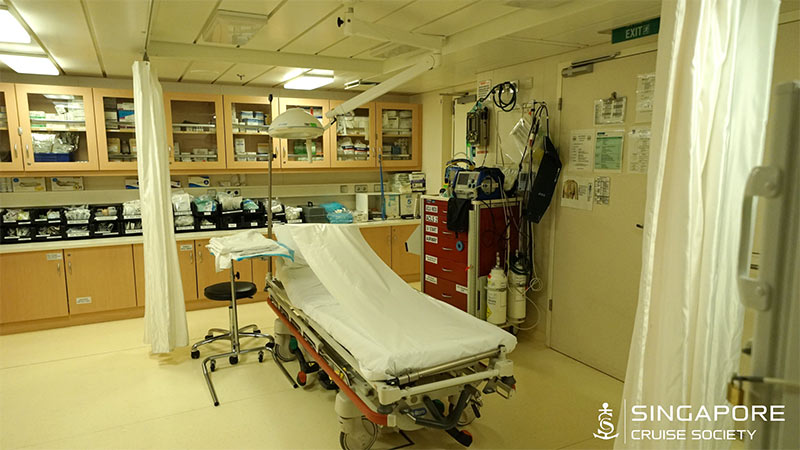
The Quantum of the Seas returned to cruising on Dec. 3 with four-day itineraries from Singapore’s Marina Bay terminal to nowhere, with no port calls, for Singapore residents only.
The ship, which can normally carry 4,100 passengers, is capped at 50 percent occupancy.
Royal Caribbean International, in cooperation with the Singapore Tourism Board, has put in place many new measures to limit the risk of COVID-19 onboard its ships.
The Singapore Cruise Society breaks down these measures in detail and explains how positive cases, such as the one that was registered on Dec. 9, will be handled.
Before Embarkation
Each guest has to take a PCR test within two to three days before the sailing and test negative.

Guests are strongly advised to complete online check-in and make an arrival appointment for their preferred time for embarkation. These staggered arrival times allow safe distancing measures to be practiced in the terminal and provide a smoother boarding process.
Passengers who do not complete the online check-in are reportedly automatically assigned the latest boarding time at 7 p.m. to ensure that the terminal does not get overcrowded.
Onboard
The new health and safety measures onboard the Quantum of the Seas are part of the suggestions provided by the Healthy Sail Panel and the Safe Management Measures by the Singapore Government.
All luggage and carry-on bags are fogged and disinfected right after stepping onboard. The areas around the ship, including corridors, are electrostatically sprayed at least once a day, while commonly touched surfaces such as elevators and stairways undergo deep sanitation every two hours.
Safety amenity kits packed with masks and hand sanitizers are provided in the stateroom on boarding day.
Mask wearing is compulsory other than when the guest is eating, drinking, or doing strenuous activities.

Menus at dining venues are now digitalized, where guests scan QR codes to access them. The sale of alcoholic beverages ceases at 10 p.m., and no public consumption is allowed after 10.30 p.m. as part of local regulations.
Instead of normal safety drills for all passengers, each guest is required to watch educational videos and proceed to their muster station at any time before the ship departs.
Special HVAC systems are used to ensure no air recirculation. The upgraded system replaces ‘used’ air regularly with fresh ocean air from the outside. This process can occur up to 12 times an hour in staterooms and 15 times in public areas.
No gatherings of more than five people are allowed onboard.
Occupancies in the theater and entertainment venue will be capped at a maximum of 250 guests.
Seats are blocked to enable safe distancing between groups. However, to ensure no one misses their production show, extended hours and increased show times will be offered for popular items.

On top of Singapore’s contact tracing initiative TraceTogether – which is an application or token that utilizes Bluetooth to record close contacts – Royal Caribbean has also introduced a new wearable technology called ‘The Tracelet’, which is a bracelet all guests must wear on their wrists. Entry Tapping Points have also been set up at entrances to restaurants and theaters to allow guests to tap their SeaPass card as an added method of contact tracing. Staff will be stationed at various points to ensure that guests always have their SeaPass card, Tracelet, and TraceTogether token/app.
Tracelets are reportedly designed to work as WOW bands, allowing guests to make purchases and open stateroom doors, but these features are not ready for rollout just yet.
Onboard Medical Center
The upgraded medical center has new negative pressure areas and isolation cabins fitted with HEPA filters. There are now two doctors onboard and five registered nurses, one of whom is the newly appointed Infectious Disease Control Officer that oversees all new health and safety protocols onboard.

The medical center is now able to run eight PCR tests simultaneously, which take about 20 minutes to show result.
After Sailing
Disembarking the vessel at the end of the voyage is staggered like the embarkation process. Before leaving the terminal, all guests have to go through an Antigen Rapid Test – this was made mandatory by the Singapore Government.
What If?
What happens if someone tests positive for coronavirus was perfectly illustrated on the third sailing of the Quantum of the Seas.
The Dec. 9 announcement of a positive COVID-19 case onboard came as a shock to Singapore, where the Royal Caribbean ship was sailing, and the world. The 1,680 guests onboard, along with 1,148 crew, made a beeline back to port and arrived in Singapore within six hours after the guest tested positive.
The 82-year-old passenger who tested positive for coronavirus onboard was then evacuated to a local hospital where the three subsequent tests showed a negative result.
The Singapore Cruise Society believes it might have been a case of ‘false-positive.’ However, this dire situation showed that the system implemented by the Royal Caribbean Group and the Singapore Tourism Board works well.




